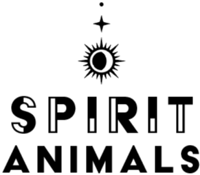
Kookaburra
Laughter, Communication and Awakening.

- Cards
- Spirit Animals Oracle Deck
- Kookaburra
Discovering The Kookaburra Spirit
Amidst the Australian wilderness, the kookaburra emerges as a symbol of profound significance, embodying essential qualities of laughter, communication, and awakening. With its distinct call that echoes through the treetops, the kookaburra becomes a bearer of spiritual medicine, guiding us on a transformative journey of finding humor in challenging situations, enhancing our communication skills, and awakening us to new perspectives that can enrich our lives.
At the core of the kookaburra's symbolism lies the essence of laughter. As it bursts into its infectious laughter-like call, the kookaburra exemplifies the art of finding lightness in the face of adversity. The spiritual medicine of the kookaburra encourages us to seek humor in life's challenging situations, to not take ourselves too seriously, and to learn to navigate difficulties with a sense of joy.
Beyond laughter, the kookaburra epitomizes communication. In its vocal exchanges with other kookaburras, the bird showcases the importance of clear and effective communication. The spiritual energy of the kookaburra urges us to enhance our communication skills, to listen attentively, and to express ourselves authentically.
The kookaburra's medicine lies in inspiring us to awaken our senses to the beauty of the natural world. In its harmonious existence within its environment, the kookaburra becomes a reminder of our interconnectedness with nature.
Prefer to listen to this article?
Check out our podcast!
Newsletter
- Spirit Animals ↓
- See All
- Alligator
- Anaconda
- Ant
- Arabian Oryx
- Beaver
- Bee
- Beetle
- Black Bear
- Buffalo
- Butterfly
- Camel
- Cat
- Cheetah
- Chimpanzee
- Condor
- Coyote
- Crab
- Dog
- Dolphin
- Dove
- Dragonfly
- Elephant
- Elk
- Emu
- Falcon
- Flamingo
- Fox
- Frog
- Gazelle
- Giraffe
- Goose
- Gorilla
- Grasshopper
- Hawk
- Hedgehog
- Hippopotamus
- Horse
- Hummingbird
- Hyena
- Jaguar
- Kangaroo
- Kiwi
- Koala
- Koi Fish
- Komodo Dragon
- Kookaburra
- Ladybug
- Lamb
- Lemur
- Lion
- Lizard
- Llama
- Manatee
- Mandarin Duck
- Meerkat
- Monkey
- Moose
- Mountain Goat
- Mouse
- Nightingale
- Octopus
- Orca Whale
- Otter
- Owl
- Ox
- Panda
- Panther
- Parrot
- Peacock
- Polar Bear
- Quetzal
- Rabbit
- Raccoon
- Raven
- Rhinoceros
- Rooster
- Salmon
- Sea Turtle
- Seahorse
- Shark
- Sloth
- Snake
- Snow Leopard
- Spider
- Squirrel
- Starfish
- Swan
- Tiger
- Tortoise
- Whale
- Wolf
- Wombat
- Zebra
What Does The Kookaburra Represent?
The kookaburra possesses a unique set of qualities that make it a fascinating and charismatic bird. Known for its distinctive laughter-like call, the kookaburra is often associated with joy and lightheartedness. Its sturdy build and powerful beak enable it to be an efficient predator, preying on small vertebrates and insects. Despite its hunting prowess, the kookaburra displays a curious and friendly nature towards humans, making it a beloved and approachable bird in many cultures. Its ability to adapt to various environments, including forests, woodlands, and urban areas, showcases its versatility and resilience. The kookaburra's confident and social behavior, often seen in groups or family units, highlights its strong sense of community and cooperation. Overall, the kookaburra's qualities reflect a balance of strength, playfulness, and social connection, making it a delightful and cherished symbol in both nature and human societies.
Keep reading ↓
Supporting content
Cultural and Mythological Significance Of The Kookaburra Spirit
The kookaburra holds significant cultural and mythological importance, particularly in Indigenous Australian traditions. Revered as a sacred and powerful creature, the kookaburra is often associated with creation stories and spiritual beliefs. In some Aboriginal cultures, the kookaburra's laughter-like call is believed to signal the coming of rain, which is vital for the land's fertility and sustenance. The bird's appearance in mythological tales represents a bridge between the human world and the spirit world, conveying messages from the divine. Its connection to ancestral spirits and its role as a messenger of wisdom and guidance make it a symbol of spiritual communication and divine protection. The kookaburra's presence is also depicted in various forms of art, music, and storytelling, reflecting its profound impact on the cultural identity and spiritual connection of Indigenous communities. Beyond its Indigenous significance, the kookaburra's distinct call and charismatic nature have captured the imagination of people worldwide, making it an endearing symbol of Australia's rich wildlife and cultural heritage.
Keep reading ↓
Marketing Specialist
Supporting content
A Kookaburra In My Deams
Dreaming of a kookaburra holds various symbolic meanings and messages. The kookaburra is often associated with laughter, joy, and merriment due to its distinctive and infectious call that resembles hearty laughter. When it appears in a dream, it may signify a time of happiness and positivity in one's waking life. The presence of a kookaburra in a dream can also symbolize a sense of freedom and the need to embrace spontaneity and playfulness. Just like the kookaburra's ability to fly freely through the skies, the dream might be encouraging the dreamer to release any inhibitions and enjoy life to the fullest.
Furthermore, the kookaburra's laughing call may represent the need to find humor and lightness in challenging situations. It serves as a reminder to approach life's difficulties with a positive outlook and a sense of resilience. The kookaburra's laughter in a dream could be a gentle nudge to maintain a sense of levity even during tough times.
In some cultures, the kookaburra is regarded as a messenger of good luck or a sign of favorable changes to come. Dreaming of this bird may indicate that positive transformations and opportunities are on the horizon.
Overall, the presence of the kookaburra in a dream encourages individuals to approach life with a sense of joy, optimism, and adaptability. It reminds the dreamer to appreciate the beauty of nature and the simple pleasures that surround them, encouraging a deeper connection with the natural world and a greater sense of inner peace and contentment. Embracing the qualities of the kookaburra in waking life can lead to a more harmonious and fulfilling existence.
Keep reading ↓
Habitat, Behaviours and Ecological Importance Of The Kookaburra
Habitat:
The kookaburra is native to Australia and is found in a wide range of habitats throughout the continent. It is most commonly associated with woodlands, forests, and open eucalyptus forests, where it perches on branches and tree trunks, scanning the surroundings for prey. Kookaburras are also frequently seen near water bodies, such as rivers, lakes, and streams, as they rely on water for drinking and hunting aquatic prey like fish and crustaceans. They are highly adaptable birds and can be found in both urban and rural areas, including parks, gardens, and residential neighborhoods. The availability of suitable nesting sites, such as tree hollows or termite mounds, is crucial for their survival, and they will often use abandoned nests of other birds. The kookaburra's ability to thrive in diverse environments has contributed to its widespread presence across various parts of Australia, making it a familiar and cherished resident of the Australian landscape.
Behaviours:
- Laughing Call: One of the most distinctive behaviors of the kookaburra is its loud, raucous call, often referred to as a "laugh." This laughing call is not only a way to communicate with other members of its family group but also serves as a territorial display to warn other kookaburras to stay away.
- Hunting Technique: Kookaburras are carnivorous birds and are skilled hunters. They have a unique hunting technique where they perch on a high vantage point, such as a tree branch, and scan the ground below for potential prey. Once they spot a small animal like insects, small mammals, reptiles, or even snakes, they swoop down with precision and grasp their prey with their strong beaks.
- Family Bonds: Kookaburras are highly social birds that form tight-knit family bonds. They live in family groups that usually consist of a monogamous breeding pair and their offspring from previous years, helping in raising the new chicks. This cooperative breeding behavior ensures the survival and care of the young kookaburras.
- Territorial Behavior: Kookaburras are fiercely territorial birds, and they defend their chosen hunting territories from intruders, including other kookaburras. The laughing call serves as a warning to rival groups to stay away from their claimed area.
- Sunbathing: An interesting behavior of kookaburras is sunbathing. They have been observed spreading their wings and exposing their white chest feathers to the sun. This sunbathing behavior is believed to help regulate their body temperature and remove excess moisture from their feathers, promoting better flight performance.
Ecological Importance:
The kookaburra plays a significant ecological role in its habitat. As a carnivorous bird, it helps control the populations of small animals, including insects, small mammals, reptiles, and snakes. By preying on these species, the kookaburra helps maintain the balance in the ecosystem, preventing overpopulation of certain prey species that could have detrimental effects on vegetation or other animal populations. Additionally, the kookaburra's foraging behavior and hunting technique contribute to nutrient cycling by consuming and recycling organic matter from its prey.
Keep reading ↓
How the Kookaburra Contributes To Scientific Research
The kookaburra, renowned for its distinctive laughter-like call, is a pivotal subject in ornithological and ecological research. Their vocalizations, often heard at dawn and dusk, have been analyzed for insights into avian communication, territory establishment, and mate attraction. Beyond communication, these birds have also been studied for their cooperative breeding behavior, where offspring from previous broods assist parents in rearing new chicks. Additionally, as urbanization encroaches upon their natural habitats, kookaburras are becoming models for understanding wildlife adaptation to human-dominated landscapes, providing invaluable data for conservationists.
Keep reading ↓
Guided Visualization To Connect With The Kookaburra Spirit
Complement your ritual with...
Binaural beats!
Close your eyes and take a few deep breaths, allowing yourself to relax and let go of any tension or distractions. Imagine yourself standing in a peaceful and serene forest. The air is crisp and fresh, and the scent of the earth fills your senses. As you walk deeper into the woods, you come across a magnificent kookaburra perched on a branch, its vibrant blue and brown plumage shining in the dappled sunlight.
Approach the kookaburra with a sense of curiosity and respect, and as you do, you notice a gentle laughter emanating from its beak. This laughter fills the air around you, bringing with it a feeling of joy and lightness. The kookaburra looks into your eyes, and you feel a deep connection with its wise and knowing gaze.
With an open heart and mind, you extend your hand toward the kookaburra, inviting it to come closer. As it hops onto your outstretched arm, you feel a surge of energy and vitality flowing through you. You are now connected with the spirit of the kookaburra, and you feel its wisdom and playfulness merging with your own.
Together, you and the kookaburra take flight, soaring high above the forest canopy. You feel the wind against your face and the freedom of being one with the sky. As you glide through the air, the kookaburra's laughter guides you on a journey of self-discovery and transformation.
With the kookaburra by your side, you explore the depths of your inner world, uncovering hidden truths and gaining insights into your true self. You embrace the spirit of laughter and merriment, allowing yourself to let go of worries and fears, and fully embrace the present moment.
As you continue your flight with the kookaburra, you feel a sense of peace and harmony within you. The laughter of the kookaburra becomes a part of you, reminding you to find joy in the simplest of things and to approach life with a light-hearted attitude.
When you are ready to return, the kookaburra gently lands back on the branch where you first met. You thank the spirit of the kookaburra for its guidance and companionship, knowing that its wisdom and laughter will always be with you.
Take a few more deep breaths, and slowly bring yourself back to the present moment. Carry the spirit of the kookaburra with you, knowing that you can always connect with its energy whenever you need guidance, joy, and a reminder to live life to the fullest.
Shop
Connect with the essence of our Spirit Animals!

Beach Towel
Buy Now

Flag Wall Art
Buy Now

Sherpa Blanket
Buy Now

Oracle Decks
Buy Now
From Our Blog
Stay up to date with our latest articles!

What Leadership Really Means (And What We’re Forgetting)

Brains, Hearts & Bold Moves with Lara Stalquist

What’s Really Worth Stressing About? Reclaiming Your Peace In A World That’s Always “On”
Please note:
It is crucial to acknowledge that the symbology and interpretations can differ greatly among various cultures, religious ideologies, and individual viewpoints. The significance and comprehension of these spirit animals may vary depending on the particular mythological backdrop or the spiritual and philosophical framework through which they are approached. The descriptions of these Oracle Cards are based on information gathered from various sources. Our aim is to provide an overview and a fictional interpretation and we cannot guarantee the accuracy or completeness of this information. The artwork featured on these Oracle Cards have been crafted by digital artists and designers, Relmi Damiano and Sacha Damiano, in conjunction with Artificial Intelligence that has been enhanced by human intervention. The visual imagery serves as a fictional representation of some of the symbols associated with these goddesses throughout history.

